|
April 1949 Popular Science
 [Table of Contents] [Table of Contents]
Wax nostalgic about and learn from the history of early
electronics. See articles from
Popular
Science, published 1872-2021. All copyrights hereby acknowledged.
|
A Wikipedia on the history
of
nuclear power shows a photo of the first light bulbs ever lit by electricity
generated by nuclear power, at EBR-1 at Argonne National Laboratory-West, December
20, 1951. That was two years after this "U.S. Lights New Atomic Pile for Peace" article
in Popular Science magazine, which discusses progress at the
Brookhaven
National Laboratory, located in New York state. It opened in 1947. Much public
excitement - and fear - was fomented over the use of nuclear energy, which had just
four years earlier been used to bring an end to World War II through its awesome
level of concentrated destructiveness, for peaceful uses like generating electrical
power and for medicine. During the postwar era, many such articles, which some considered
propaganda, were published, television shows aired, and movies produced in attempts
to turn the public into pro- or anti- nuclear power activists. The "anti's" have
done a pretty good scaring everyone to the point where rather than benefitting from
the very "green" aspects of nuclear power (which would have been continually improving
in technology), they instead are accepting monstrous installations of solar arrays,
wind turbine farms, and other impractical technologies. Their cost to society, economies,
and the environment are rarely reported honestly.
U.S. Lights New Atomic Pile for Peace
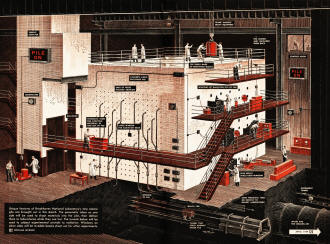
Unique features of Brookhaven National Laboratory's new atomic
pile are brought out in this sketch. The pneumatic tubes on one side will be used
to shoot materials into the pile, then deliver them to laboratories while they are
hot. The tunnels below will be used to subject experimental animals to radiation.
Windows on other sides will let invisible beams shoot out for other experiments.
Popular Science shows you the innards of Brookhaven's nuclear furnace.
By Martin Mann
Sometime this summer a young man in a sports jacket will twist a few knobs with
his eyes fixed on a Geiger counter, then turn and say, "It's critical." The atomic
pile at Brookhaven National Laboratory then will be running under its own "steam."
This, the fourteenth furnace ever built to release and control the terrifying
forces in the heart of the atom, will be the world's most powerful air-cooled pile.
Only the water-cooled giants that manufacture plutonium for bombs at Hanford, Wash.,
out-range it in the U. S. Brookhaven's pile, however, will not make fuel for bombs,
and may not produce any usable power. Instead, it will produce more wrinkles in
men's brows - by increasing their knowledge.
Drive out Long Island's Jericho Turnpike 65 miles from New York City to the edge
of the duck- and potato-farm country, then turn off at an inconspicuous sign marked
"Brookhaven National Laboratory," and you will quickly spot a big, striped smokestack.
It towers above a group of modest frame and concrete-block buildings that house
the laboratory. The smokestack and the most imposing buildings are on the side of
Rutherford Hill - named for Sir Ernest Rutherford, the British physicist who laid
the foundations of nuclear theory.
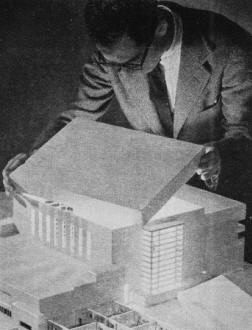
Model shows unusual features of building that houses uranium
pile now nearing completion at imposing research laboratory on Long Island.
The biggest building, a light brick structure six stories tall, with two gigantic,
green-glassed bay windows, contains the pile. It has two lower wings for laboratories
especially designed and equipped for workers with radioactive chemicals. And there
is a detached building in the rear for the "hottest" laboratory, where experiments
with intensely radioactive substances can be conducted by remote control. Nearby
are the fan house, cooling towers, and stack.
No smoke will ever belch from the stack of this plant (PS, Nov. '48, p. 108).
Instead it will release the cooling air that gigantic fans will whirl through the
pile at a rate of many tons a minute. And this radioactive air will come out of
the stack only when atmospheric conditions are such that it will be safely dispersed.
To go inside and see the pile itself, you need a "Q" clearance from the Atomic
Energy Commission. The drawing on pages 122 and 123, however, shows you even more
than would meet your eye : if you walked into the huge room containing the beige-painted
concrete cube, about 40 feet on a side. Only three faces and the top are exposed.
The back - not visible in the drawing - is where the uranium is put in. Because
this pile "burns" so fast, a new charge will be needed at least every few years.
The three visible sides bristle with balconies, tubes, rods, switchboxes, and
wiring. On the two parallel working faces are seven rows of small windows. Most
of these are about four inches square. These windows go directly into the hot heart
of the pile. Material can be inserted through them for irradiation inside the pile.
And beams of neutrons, gamma rays, and all the other kinds of particles and waves
can be let out of the pile through them. The windows extend all the way through
to both faces, in case something placed inside has to he pushed out. Balconies sticking
out from the faces of the pile give easy access to the upper rows of windows.
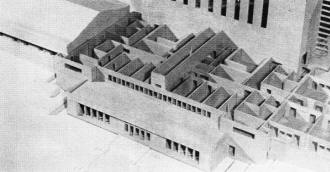
Scale model of the pile building has removable
sections to show details of layout. Corridor that provides path for 60-ft. neutron
beam can be seen in center. Layout of halls gives two routes to each laboratory
(in right and left wings) in case one path is blocked by an accident.
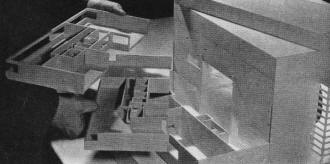
Back view of the model shows section where the
uranium metal will be handled. Shop for machining it and vault for storing it are
on lower floor, other shops and offices above. Large door to pile room provides
access to entire "lattice" - the openings that hold the uranium rods.
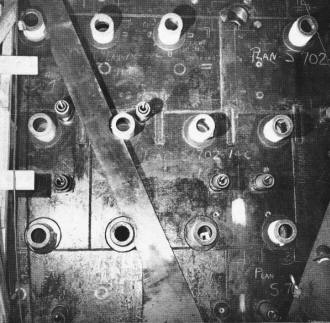
Atom's-eye view of the pile from inside of it.
This photo, made during construction, shows inside of one face with openings that
let materials in, radiation out. Note workman at right.
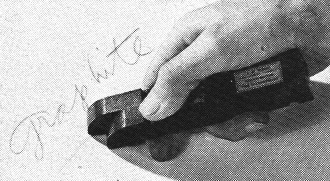
Most of the pile is graphite, like lead in pencil.
You can actually write with it. Above is model of one of more than 60,000 graphite
bricks used.

Tunnels for cars that will carry animals and
instruments under the pile were set in the massive foundation. Openings in the tunnels
will expose the cars and their contents to radiation.

These men will lead the search for knowledge made possible by
the pile. Dr. Lyle B. Borst (left) heads the pile project, and Dr. Leland J. Haworth
(right) is director of Brookhaven.
The north face of the pile (directly in front of you in the drawing) has a system
of pneumatic tubes that reach into its center. These tubes are like those used in
department stores to relay orders and make change. Here they will be used to shoot
material into the pile to be bombarded with neutrons, and to whisk back the newly
made isotopes. This arrangement permits study of short-lived isotopes, the ones
that lose their radioactivity and change into something else in a few minutes or
even seconds.
Some of the pneumatic tubes end at the pile face itself; others extend under
the floor into nearby laboratories, so that the isotopes can be delivered straight
to a scientist's workbench. It is even possible to connect the tubes directly to
experimental equipment, so that a fresh radioisotope will pop right into a test
tube or flask and immediately become part of an experiment.
On the same face of the pile you can also see the lattice - the ends of the openings
that hold the uranium rods. These openings extend through the pile. The actual loading
and unloading, however, always will be done from the opposite side.
One other opening in the south face is a large one, about a foot square, set
in the very center. It allows a beam of neutrons to shoot out of the pile and down
a corridor built for it through the adjacent laboratories and offices. Such a beam,
60 feet long, may help experimenters determine the extent to which distance affects
the ability of various materials to absorb neutrons.
When the pile is cut off, scientists may also work on top of it. The top is made
up of 4-ft. square concrete blocks that can be lifted out to make openings wherever
the researchers want them. These large openings do not give access to the center
of the pile, but merely expose its outer graphite shell. A lot of slow-moving neutrons
leak through the shell (this "leakage flux" is about 1/50 as intense as the neutron
beams from the heart of the pile) and can be used for experiments in big apparatus
placed over the opening in the shield.
Tunnels for Tests with Animals
As a visitor to the pile room, you might also notice trapdoors in the floor.
They lead to two tunnels that pass directly underneath the pile. In each tunnel
there is a small car, pulled by motor-driven chains, that can be moved back and
forth through the tunnel and stopped under an opening in the pile's bottom shield.
The smaller car is for exposing instruments to the full blast of radiation from
the pile. The larger one can carry animals as big as chimpanzees.
Animal experiments may reveal a cure for radiation sickness - whether caused
by an accident or a bomb - and may also tell much about cancer, heredity, and the
other biological mysteries. This is the first installation permitting studies with
animals of near-human size and complexity. Previous work at Oak Ridge has been limited
mainly to rats and rabbits.
Inside the concrete cube there are 60,000 pieces of graphite, which resembles
the lead in your pencil but is nearly 100 percent pure. There are 2,600 different
sizes and shapes of these pieces. Putting them together was like assembling a colossal
Chinese puzzle. These thousands of "bricks" were made so accurately that they fit
together to form an almost airtight mass without needing cement or mortar between
their joints.
Inside this graphite block, within the concrete cube, is a maze of channels.
Aluminum cans containing the long rods of uranium that make the pile powerful fit
into some of them. Others are for the cadmium rods, which the operators can slide
in and out like pistons to regulate the rapidity with which the invisible neutrons
split the invisible atoms of uranium. Still others are the ducts through which the
air to cool the pile circulates.
Fuel Is a Mixture of Isotopes
The uranium in the Brookhaven pile is "natural" material. It is highly purified,
but is still a mixture of the three isotopes - U-234, U-235, and U-238. Only the
U-235 atoms fission (split), and they are barely 0.7 per-cent of the total.
Nevertheless, the Brookhaven pile will run at fairly high power - unofficially
estimated at about 5,000 kilowatts or more. Most of this power will be wasted, but
about 1,500 kilowatts could be converted into electricity to help run the cooling
fans. (Outside power would still be needed for the fans, however, since they draw
much more than 1,500 kilowatts.) If this is done, the Brookhaven pile will become
the first in America to generate useful electric power.
But the new pile will not produce anything like 5,000 kilowatts immediately.
At first its power output will be nearer zero. For it will be "warmed up" slowly
and will not be operated at full power until, possibly, sometime in July. This slow
rise in output will give the engineers a rare opportunity to learn things that cannot
be learned after a pile has its full load of fuel. During this build-up period,
scientists will study the pile closely, watching the neutron production in various
sections, the changes in the graphite bricks, the effects or weather conditions,
the way the control changes with increasing power, and how fission products build
up in various parts of the pile.
By next fall the research program for which the pile is being built should be
running full blast. It will cover nearly every field of science - physics, chemistry,
biology, medicine, and all the rest. But much of it will be concentrated on chemical
and metallurgical problems related to materials used in piles. For materials are
the main stumbling block to atomic progress now. If the engineers had the right
materials, they could design good nuclear engines for power plants, rockets, airplanes,
or warships in a jiffy.
Will Gold Shield Atomic Engines?
Shielding is one of the toughest problems. The shield on the Brookhaven pile
- the part you can see - is made of a special, secret kind of concrete at least
six feet thick. You can't put that heavy a shield in an atomic rocket, or even a
battleship. But what can you use that's lighter? Professor Walter C. Whitman, head
of the chemical engineering department at M.I.T., recently made a study of light
shielding materials for the Atomic Energy Commission. His report: the cheapest shield
now available would be 24-karat gold!
Another big problem is finding structural materials to use inside an atomic engine.
Most ordinary things either react badly with neutrons or melt under the high temperatures.
Steel absorbs neutrons so fast that it would stop a pile completely. For a while,
the unusual metal titanium (now used in white paint) looked like a good bet, but
it has not lived up to expectations. Zirconium might work, but it is always accompanied
by hafnium, which is bad. Rubidium and caesium, two other possibilities, are too
scarce.
Then there is the ash headache. When a U-235 atom fissions, it breaks into two
pieces - two new elements each weighing somewhere around half as much as uranium.
(These fission products are not always the same elements, but may be any of the
24 that range from selenium to lanthanum in the periodic table.) The fission products
will not fission themselves. Worse than that, they absorb neutrons, reducing the
power of the pile. Nucleonics experts call this process "poisoning the pile."
The poisons, or nuclear ashes, have to be taken out after the pile has operated
a while. But mixed in with the ashes is a lot of good, fissionable uranium far too
valuable to throwaway. As Sumner Pike, one of the members of the AEC, once said,
a pile is like an inefficient coal furnace that lets unburned coal fall into the
ash pit. You can shake the ashes, get that coal out, and put it back in the furnace.
But the nuclear "ashes" must be shaken at least 10 times to get all the uranium
out. These ashes also contain plutonium, the fissionable stuff in bombs, and other
materials so radioactive that you dare not get too close to them even if you wear
an asbestos suit.
So ways must be found to reduce the poisoning effect of the fission products,
so that the ashes won't have to be shaken so many times. More efficient and cheaper
methods of doing the shaking must be learned, too. Present estimates indicate that
a plant for shaking an atomic ash barrel would cost as much as the atomic power
plant it would accompany. And somebody has to figure out an easy way to get rid
of the left-over radioactive "garbage," now mostly buried in huge underground tanks.
The Brookhaven experimenters may not answer these questions - or even attack
them directly. Brookhaven's scientists merely seek facts, any kind of facts, not
just those dealing with power plants and rocket motors. Yet the basic facts of nature
are the bricks out of which some men, somewhere, sometime, will build power plants
and rocket motors.
Posted April 10, 2024
|

















